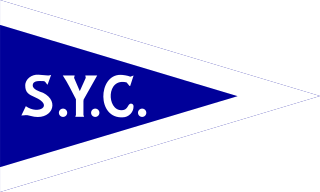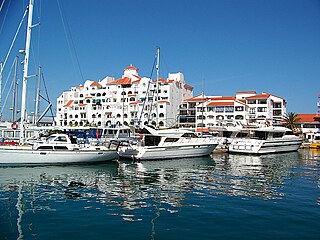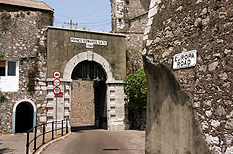
Cowes Week is one of the longest-running regular regattas in the world. With 40 daily sailing races, up to 1,000 boats, and 8,000 competitors ranging from Olympic and world-class professionals to weekend sailors, it is the largest sailing regatta of its kind in the world. Having started in 1826, the event is held in August each year on the Solent, and is run by Cowes Week Limited in the small town of Cowes on the Isle of Wight.

The Royal Yacht Squadron (RYS) is a British yacht club. Its clubhouse is Cowes Castle on the Isle of Wight in the United Kingdom. Member yachts are given the suffix RYS to their names, and are permitted to wear the White Ensign of the Royal Navy rather than the merchant Red Ensign worn by the majority of other UK registered vessels. The club's patron was Queen Elizabeth II.
Boat racing is a sport in which boats, or other types of watercraft, race on water. Boat racing powered by oars is recorded as having occurred in ancient Egypt, and it is likely that people have engaged in races involving boats and other water-borne craft for as long as such watercraft have existed.

The Southern Yacht Club is located in New Orleans, Louisiana's West End neighborhood, on the shores of Lake Pontchartrain. Established on July 21, 1849, it is the fifth oldest yacht club in the United States and a founding member of the Gulf Yachting Association.

The Royal Cork Yacht Club is a yacht club located in Crosshaven, County Cork, Ireland. Founded in 1720, it is a claimant to the title of the world's oldest yacht club, although this is challenged by the Neva Yacht Club in Russia.

The Royal Bombay Yacht Club (RBYC) is one of the premier gentlemen's clubs which was founded in 1846 in Colaba, an area of Mumbai in India. The building was designed by John Adams, who also designed the nearby Royal Alfred Sailors' Homes, and was completed in 1896.

The Royal Thames Yacht Club (RTYC) is the oldest continuously operating yacht club in the world, and the oldest yacht club in the United Kingdom. Its headquarters are located at 60 Knightsbridge, London, England, overlooking Hyde Park. The club's purpose is "to provide the members with outstanding yacht cruising, racing and social opportunities in the UK and internationally, building on the club's unique heritage, central London facilities and close reciprocal relationships with other leading yacht clubs around the world."

Yachting Association of Sri Lanka (YASL) is recognised by the International Sailing Federation as the governing body for the sport of sailing in Sri Lanka.

Peter John "PJ" Montgomery is a New Zealand sports broadcaster. His work has covered many sports, but he is best known as "The Voice of the America's Cup" on New Zealand and International radio and television. He is often remembered for "The America's Cup is now New Zealand's Cup", his summary when New Zealand won their first America's Cup in San Diego in 1995. The line was voted the most memorable sporting commentary moment in history by the Sunday Star Times.

Marina Bay is the largest of three marinas in the British Overseas Territory of Gibraltar, at the southern end of the Iberian Peninsula. It is located in the Bay of Gibraltar, between the North Mole of Gibraltar Harbour and the runway of Gibraltar International Airport. Marina Bay and the adjacent Ocean Village Marina together have been incorporated into the Ocean Village Project.

The Queensway Quay Marina is one of three marinas in the British Overseas Territory of Gibraltar, at the southern end of the Iberian Peninsula. The yachting facility is located at the eastern aspect of the middle section of Gibraltar Harbour. It is the site of what may be the oldest wharf in Gibraltar, Ragged Staff Wharf.

Rosia Bay is the only natural harbour in Gibraltar, the British Overseas Territory at the southern end of the Iberian Peninsula. Formerly referred to as Rosia Harbour, it is located on the southwest side of Gibraltar. Rosia Bay was the site of the Royal Navy Victualling Yard complex which was constructed in the early 19th century, allowing vessels to anchor and obtain provisions, including food and water. Vice Admiral Horatio Nelson obtained supplies for his Mediterranean Fleet at Rosia Bay. It was to that same anchorage that his vessel HMS Victory was towed after Nelson's death in the 1805 Battle of Trafalgar. The area is also the location of gun batteries, including Parson's Lodge Battery at the south end of the bay and Napier of Magdala Battery at the north end. In the 21st century, Rosia Bay was the focus of controversy following the government's demolition of the historic Rosia Water Tanks and construction of the affordable housing development Nelson's View, which necessitated the relocation of the owners of the adjacent 19th century Rosia Cottages.

Profield Contractors, also referred to as Profield Contractors Ltd, is a Gibraltar-based construction company founded in 1989. The company has worked on a number of general construction and civil engineering projects in Gibraltar.

The Royal Naval Hospital Gibraltar (RNH Gibraltar), formerly the British Military Hospital Gibraltar (BMH Gibraltar), was a military hospital founded c. 1903 to provide healthcare for British military personnel and local sailors. The facility, located on Europa Road in the British Overseas Territory of Gibraltar's South District, comprised three buildings. The hospital was transferred to the Royal Navy in 1963. It closed in 2008, and underwent residential conversion that began prior to the hospital's closure.

The Royal Calpe Hunt of the British Crown Colony of Gibraltar originated in 1812 as the Civil Hunt. The fox hunt was initially a civilian endeavour that began when a pair of English foxhounds were imported to Gibraltar. The hunts took place across the border, in the Campo de Gibraltar area of Spain. However, in 1814, the membership of the Hunt underwent a substantial change. Many officers of the Gibraltar garrison joined the Hunt, which shifted from a civilian to a military enterprise. That year, the name was changed to the Civil Calpe Hunt. It retained that title until 1817, after which it was known as the Calpe Hunt. The first Master of the Hunt was Charles Elphinstone Fleeming. However, the Master most associated with the Hunt was Pablo Larios, Marquis of Marzales, who held that title for forty-five years. His election to that position in 1891 was not only historic, but strategic. His appointment represented only the second time that the position had not been filled by a member of the military. In addition, his Spanish heritage and influence in the Campo de Gibraltar, where he owned extensive estates, garnered him the loyalty of the local Spanish farmers, and therefore eased the ever-present tensions between the military and the farmers over the crop damage that was inherent to the Hunt. In 1906, King Edward VII of the United Kingdom and King Alfonso XIII of Spain became joint Patrons of the Hunt, after which it was known as the Royal Calpe Hunt. The tradition of the Hunt continued for more than a century, until 1939, and the onset of the Second World War

Prince Edward's Gate is a city gate at the entrance to Prince Edward's Road in the British Overseas Territory of Gibraltar. It cuts through Charles V Wall, one of the 16th century fortifications of Gibraltar at the former southern limit of the city. The gate is adjacent to the west wall of the Flat Bastion, another 16th-century fortification. The gate was named after Prince Edward, the future Duke of Kent, and was opened in 1790, the same year the prince arrived at Gibraltar as commander of the 7th Regiment of Foot. While the gate now has a limited role in the defence of Gibraltar, it continues to provide vehicular and pedestrian access through Charles V Wall. Prince Edward's Gate is listed with the Gibraltar Heritage Trust.

The Southport Gates are three city gates in the British Overseas Territory of Gibraltar. They are located in the Charles V Wall, one of the 16th century fortifications of Gibraltar. The gates are clustered together, with the South Bastion to the west, and the Trafalgar Cemetery to the east. The first and second Southport Gates were constructed at present day Trafalgar Road in 1552 and 1883, respectively. The third gate, Referendum Gate, is the widest of the three and was constructed in 1967 at Main Street, immediately west of the first two gates. The Southport Gates are listed with the Gibraltar Heritage Trust.

Streets in the British Overseas Territory of Gibraltar are represented by road signs as in the United Kingdom. As of 2007, Gibraltar has a network of 29 kilometres (18 mi) of roads.

King's Bastion is a coastal bastion on the western front of the fortifications of the British overseas territory of Gibraltar, protruding from the Line Wall Curtain. It is located between Line Wall Road and Queensway and overlooks the Bay of Gibraltar. It played a crucial role in defending The Rock during the Great Siege of Gibraltar. In more recent history the bastion was converted into a generating station which powered Gibraltar's electricity needs. Today it continues to serve the community as Gibraltar's leisure centre.
The Royal Madras Yacht Club (RMYC) is a yacht club in Chennai, India. The RMYC was founded by Sir Francis Spring in 1911. It was the first sailing club in southern India, and was originally based in what was called the Timber Pond area of Madras Harbour. Soon after its founding the club was granted royal patronage by George V, and it became one of the most prestigious sporting and social clubs in British India. Today the club is located at Springhaven Wharf, named after its founder.






















